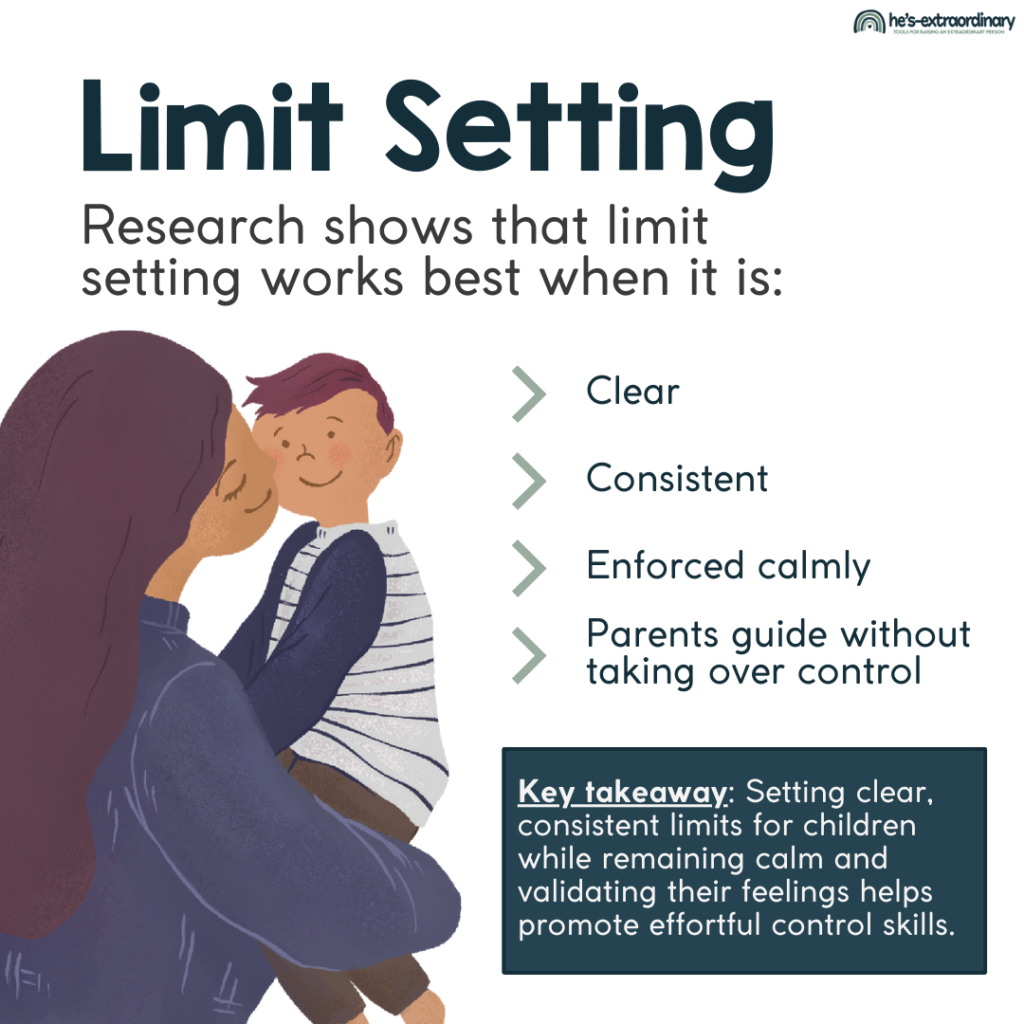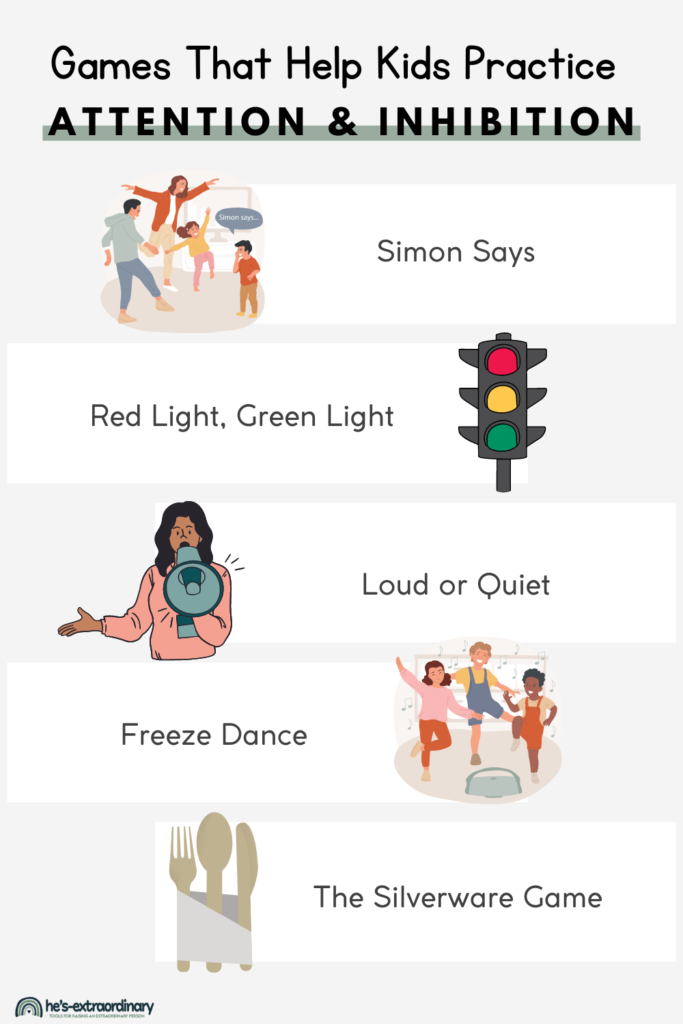Boosting Effortful Control: Strategies and Techniques
What’s inside this article: A look at developing effortful control, an essential skill for children’s’ success. Including what research tells us, activities, and parenting styles that promote the healthy development of effortful control.
Effortful control means using direct effort to inhibit or control behavior.
So, when your child’s running down the hall, and you call out, “Walking feet!” and they stop running – that’s using effortful control.
By definition, it’s the ability to inhibit a dominant response in order to perform a subdominant response. Effortful control is deeply tied to self-regulation.
Development of Effortful Control
Effortful control comes before self-control.
It’s an essential skill that’s associated with behavior, social skills, and academic achievement. It typically develops rapidly in children who are aged three to four years old.
Effortful control is also needed for delayed gratification, emotional regulation, and moral development.
Through research, we know that children who struggle with self-regulation have significantly more trouble with effortful control than their peers.
What happens when kids struggle with this skill?
Through research, we know that as children get older, they are increasingly held responsible for their actions. Often, this means adults respond more negatively to inappropriate behaviors, resulting from poor effortful control.
This is because the older children are, the higher expectations we have when it comes to behavior.
With toddlers – adults tend to respond warmly and redirect misbehavior. But, with older children, they will visibly show their disapproval and implement consequences when children don’t listen.
The problem is that all research related to effortful control shows that children develop this ability best during positive interactions.
So when kids don’t develop effortful control when they’re three or four years old like their peers, and they struggle with self-regulation – what happens next is their ability to develop these skills becomes impeded by negative interactions.
This leads to more incompliance and basically results in a cycle of negativity.
Strategies for Boosting Effortful Control
Is your child the type of kid who will be doing something they shouldn’t be – maybe because it’s fun, maybe because they’re dysregulated – and you’re telling them what they should be doing, but they don’t stop?
Maybe they can’t stop – because they have poor effortful control.
The National Institute of Child Health and Human Development has researched key factors that promote and inhibit effortful control. (Source)
1. Limit Setting
Research shows that limit setting promotes effortful control best when it’s:
- Clear
- Consistent
- Enforced calmly
- Parents guide without taking over control.
Their research also found that subtle differences in parents’ responses to their child’s emotional reactions impacted how effective limit setting was.
Key takeaway: Setting clear, consistent limits for children while remaining calm and validating their feelings helps promote effortful control skills.

2. Activities that Require Attention and Inhibition
All skills are developed by practicing them. It takes repetition to master any skill. How much repetition is needed varies from person to person, based on individual learning styles and personality.
Some people require a lot more practice than others.
One way you can practice effortful control with your child is with games and activities that require attention and inhibition – since these are key components to using effortful control.
Simon Says
How to Play:
One person is “Simon,” the others are the players. Standing in front of the players, Simon tells them what to do. However, the players must only obey commands that begin with the words “Simon Says.”
If Simon says, “Simon says touch your nose,” then players must touch their nose.
But, if Simon simply says, “jump,” without first saying “Simon says,” players must not jump. Those that do jump are out.
Red Light, Green Light
How to Play:
One person is chosen to be ‘it’ (the traffic light) and stands a good distance away from the other players (5+ meters) with their back to them.
The other players stand in a line facing the person whose it/
When “it” calls ‘Green Light,’ the other players move toward them until they spin around, calling it ‘Red Light.’
When they hear the red light command, the other players must freeze on the spot.
Any child seen moving must return to the starting line. The children must remain frozen until the next ‘Green Light’ command is given.
Play continues in this manner until someone reaches and tags the person who is “it”. The tagger becomes the new “it,” and the game restarts.
Loud or Quiet
How to play:
One person is the leader, and the others are the players. The leader calls out an action, for example, “clap your hands,” and a volume: loud or quiet.
When the leader says “loud,” the players clap their hands loudly. When the leader says “quiet,” the players switch to clapping quietly.
Freeze Dance
How to play:
Everybody dances to the music – someone is in control of the pause/play button.
When the music stops – everyone has to freeze on the spot and hold the dance pose they were in.
Silverware Game
How to play:
This is an easy game to play at the dinner table to practice effortful control. Say a command, like “Raise your spoon!” and everyone raises their spoon.
Then you can say “Raise your fork! …. Put down your spoon!”
Everyone follows instructions, reacting as quickly as possible to your commands.

3. Increased Structure in the Home
Not having enough structure in your home/life can lead to anxiety, compliance issues, and difficulties with transitions.
But it can also affect effortful control and self-control.
Why?
Because – kids with poor self-control are often bound to do the first thought that pops into their heads. They don’t have the inhibition or effortful control to stop and consider options, possible outcomes of their behavior, consequences, etc.
This is not because they’re bad kids. They just haven’t developed those abilities yet.
Having things like routines, visual supports, a well-structured environment, and clear task/chore systems helps keep your expectations as the first thing coming to your child’s head. Visuals can remind us of outcomes and expectations.
For help implementing structure in your home and life, read: 6 Signs Your Child Needs More Structure – How to Provide Structure so Your Child Thrives.
4. Explicit Teaching
Oftentimes, social and emotional skills are developed through interactions with adults and peers, experiencing natural consequences, observations, witnessing cause and effect, etc.
Other times – they aren’t, and it’s helpful for children to be explicitly taught the skill. This means explaining clearly and in detail, making sure there is no confusion.
Math and science are taught through explicit instruction, but often social-emotional skills aren’t. But they can be.
Here are just a couple of resources I’ve created for explicitly teaching skills around following directions, effortful control, and self-control.

